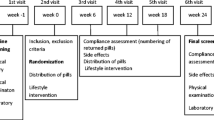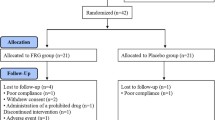Abstract
No reliable method for the estimation of chromium (Cr) status is available yet. The aim of this study is to investigate the possibility of using urinary Cr response to glucose load as an indicator of Cr status. Seventy-eight non-insulin-dependent diabetes mellitus patients were divided randomly into two groups and given Cr supplements as brewer’s yeast and CrCl3 sequentially with placebo in between, in a double-blind, crossover design of four stages, each lasting 8 wk. At the beginning and end of each stage, subjects were weighed, their dietary data and drug dosage recorded, and blood and urine samples collected for analysis of glucose and urinary chromium (fasting and 2 h post-75-g glucose load) and fructosamine.
The mean urinary Cr after the glucose load was significantly higher than the fasting mean at zero time (p<0.01). However, only 52 of the patients showed an obvious increase; the others showed a slight decrease or no change. Both supplements caused a significant increase in the means of urinary Cr and a significant decrease in the means of glucose and fructosamine. Only those subjects responding to Cr supplement by improved glucose control showed an increase in post-glucose-load urinary Cr over fasting level, after the supplement but not at zero time. Therefore, it was concluded that urinary Cr response to glucose load could be used as an indicator of Cr status.
Similar content being viewed by others
References
W.H. Glinsman and W. Merz, Effect of trivalent chromium on glucose tolerance, Metabolism 15, 510–519 (1966).
R.O. Brown, S. Forloines-Lynn, R.E. Cross, and W.D. Heizer, Chromium deficiency after long term total parenteral nutrition, Dig. Dis. Sci. 31, 661–664 (1986).
H. Freund, S. Atamian, and J.E.P. Fischer, Chromium deficiency during total parenteral nutrition, J. Am. Med. Assoc. 241, 496–498 (1979).
K.N. Jeejeebhoy, R.C. Chu, E.B. Marliss, G.R. Greenberg, and A. Bruce-Robertson, Chromium deficiency, glucose intolerance, and neuropathy reversed by chromium supplementation in a patient receiving long-term total parenteral nutrition, J. Am. Clin. Nutr. 30, 531–538 (1977).
O.B. Martinez, A.C. MacDonald, R.S. Gibson, and O. Bourn, Dietary chromium and effect of chromium supplementation on glucose tolerance of elderly Canadian women, Nutr. Res. 5, 609–620 (1985).
J.F. Potter, P. Levin, R.A. Anderson, J.M. Freiberg, R. Andres, and D. Elahi, Glucose metabolism in glucose intolerant older people during chromium supplementation, Metabolism 34, 199–204 (1985).
V.J.K. Liu, J. Nordstrom, M.B. Kohrs, E.B. Lorah, and R. Dowdy, Effects of high chromium yeast extract supplementation on serum lipids, serum insulin and glucose tolerance in older women, Fed. Proc. 36, 1123–1128 (1977).
E.G. Offenbacher and F.X. Pi-Sunyer, Beneficial effect of chromium-rich yeast on glucose tolerance and blood lipids in elderly subjects, Diabetes 29, 919–925 (1980).
R. Riales and M.J. Albrink, Effect of chromium chloride supplementation on glucose tolerance and serum lipids including high-density lipoprotein of adult men, Am. J. Clin. Nutr. 34, 2670–2678 (1981).
R.T. Mossop, Effects of chromium III on fasting glucose, cholesterol and cholesterol HDL levels in diabetes, Central Afr. J. Med. 29, 80–82 (1983).
L. Sherman, J.A. Glennon, W.J. Brech, G.H. Klomberg, and E.S. Gordon, Failure of trivalent chromium to improve hyperglycemia in diabetes mellitus, Metabolism 17, 439–442 (1968).
M.B. Rabinowitz, H.C. Gonick, S.R. Levine, and M.B. Davidson, Effects of chromium and yeast supplements on carbohydrate and lipid metabolism in diabetic men, Diabetes Care 6, 319–327 (1983).
E.G. Offenbacher, C.J. Rinco, and F.X. Pi-Sunyer, The effects of inorganic chromium and brewer’s yeast on glucose tolerance, plasma lipids, and plasma chromium in elderly subjects, Am. J. Clin. Nutr. 42, 454–461 (1985).
A. Wise, Chromium supplementation and diabetes, JAMA, 240, 2045–2046 (1978).
M.B. Rabinowitz, S.R. Levin, and H.C. Gonick, Comparison of chromium status in diabetics and normal men, Metabolism 29, 355–363 (1980).
B.W. Morris, G.J. Kemp, and C.A. Hardisty, Plasma chromium and chromium excretion in diabetics [letter], Clin. Chem. 31, 334–335 (1985).
B.W. Morris, G.J. Kemp, and C.A. Hardisty. Alterations in plasma and urine chromium in diabetes mellitus. J. Endocrinology 108, 298 (1986) (abstract).
S.M. Bahijri, A.M.B. Mufti, S.A. Mira, H. Ghafouri, and M.A. Ajabnoor. Serum and urinary chromium in diabetic and normal adults and children, Arab J. Lab. Med. 23(3), 359–374 (1997).
C.T. Gürson and G. Saner, The effect of glucose loading on urinary excretion of chromium in normal adults, in individuals from diabetic families and in diabetics, Am. J. Clin. Nutr. 31, 1158–1161 (1978).
R.A. Anderson, M.M. Polansky, N.A. Bryden, E.E. Roginski, K.Y. Patterson, C.C. Veillon, et al. Urinary chromium excretion of human subjects: effects of chromium supplementation and glucose loading, Am. J. Clin. Nutr. 36, 1184–1193 (1982).
E. Offenbacher, H. Spencer, H.J. Dowling, and F.X. Pi-Sunyer, Metabolic chromium balance, Am. J. Clin. Nutr. 44, 77–82 (1986).
C. Veillon, K.Y. Patterson, and N.A. Bryden Chromium in urine as measured by atomic absorption spectrophotometer, Clin. Chem. 12, 1251–1254 (1978).
R.N. Johnson, P.A. Metculf, and J.R. Baker, Fructosamine: a new approach to the estimation of serum glucosyl protein. An index of diabetes control, Clin. Chem. Acta 127, 87–95 (1983).
F.J. Kayne, G. Kumar, H. Laboda, and R.E. Vanderlide, Atomic absorption spectrophotometery of chromium in serum and urine with a midified Perkin Elmer 603 atomic absorption spectrophotometer. Clin. Chem. 24(12), 1251–1254 (1978).
Egyptian Nutrition Institute Food Composition Table. Nutrition Institute, Cairo (1985).
A.D. Musaiger and P. Sungpuag, Composition of Mixed Dishes Commonly Consumed in the Arabic Gulf States, Gordon & Breach, London (1985).
FAO and US Department of Agriculture Food Composition Tables for Use in the Near East, FAO & US Department of Agriculture, Rome (1982).
W. Merz and E. Roginski, Chromium metabolism: the glucose tolerance factor, in Newer Trace Elements in Nutrition, W. Merz, ed., Marcel Dekker, New York, pp. 125–153 (1971).
R.A. Anderson, N. Cheng, N.A. Bryden, M.M. Polansky, J. Chi, and J. Feng, Beneficial effects of chromium for people with diabetes, Diabetes 46, 1786–1791 (1997).
R.A. Anderson, Chromium, glucose tolerance and diabetes, J. Am. Coll. Nutr. 17(6), 548–555 (1998).
Author information
Authors and Affiliations
Rights and permissions
About this article
Cite this article
Bahijri, S.M.A., Mufti, A.M.B. Beneficial effects of chromium in people with type 2 diabetes, and urinary chromium response to glucose load as a possible indicator of status. Biol Trace Elem Res 85, 97–109 (2002). https://doi.org/10.1385/BTER:85:2:097
Received:
Revised:
Accepted:
Issue Date:
DOI: https://doi.org/10.1385/BTER:85:2:097




